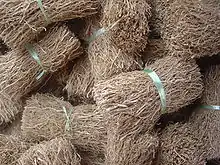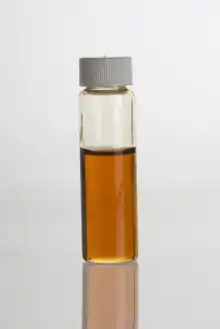Chrysopogon zizanioides
Chrysopogon zizanioides, commonly known as vetiver, is a perennial bunchgrass of the family Poaceae,
| Chrysopogon zizanioides | |
|---|---|
 | |
| Scientific classification | |
| Kingdom: | Plantae |
| Clade: | Tracheophytes |
| Clade: | Angiosperms |
| Clade: | Monocots |
| Clade: | Commelinids |
| Order: | Poales |
| Family: | Poaceae |
| Subfamily: | Panicoideae |
| Genus: | Chrysopogon |
| Species: | C. zizanioides |
| Binomial name | |
| Chrysopogon zizanioides (L.) Roberty | |
| Synonyms[1] | |
|
List
| |
Vetiver is most closely related to Sorghum but shares many morphological characteristics with other fragrant grasses, such as lemongrass (Cymbopogon citratus), citronella (Cymbopogon nardus, C. winterianus), and palmarosa (Cymbopogon martinii).
Etymology
Vetiver is the Tamil word meaning 'Cut Root'. In North India its called 'Khus' (grass).
History
During reign of Harshavardhan, Kannauj became biggest centre for aromatic trade and for the first time, vetiver tax was introduced.[2]
Description
Vetiver grows to 150 centimetres (5 ft) high and forms clumps as wide. Under favorable conditions, the erect culms can reach 3m in height.[3] The stems are tall and the leaves are long, thin, and rather rigid. The flowers are brownish-purple. Unlike most grasses, which form horizontally spreading, mat-like root systems, vetiver's roots grow downward, 2 metres (7 ft) to 4 metres (13 ft) in depth.[4]
The vetiver bunch grass has a gregarious habit and grows in tufts. Shoots growing from the underground crown make the plant frost and wildfire resistant, and allow it to survive heavy grazing pressure. The leaves can become up to 300 centimetres (10 ft) long and 8 millimetres (0.3 in) wide.[5] The panicles are 15 centimetres (6 in) to 30 centimetres (12 in) long and have whorled, 25 millimetres (1 in) to 50 millimetres (2 in) long branches.[5] The spikelets are in pairs, and there are three stamens.
The plant stems are erect and stiff. They can survive deep water flow. Under clear water, the plant can survive up to two months.
The root system of vetiver is finely structured and very strong. It can grow 3 metres (10 ft) to 4 metres (13 ft) deep within the first year. Vetiver has neither stolons nor rhizomes. Because of all these characteristics, the vetiver plant is highly drought-tolerant and can help to protect soil against sheet erosion. In case of sediment deposition, new roots can grow out of buried nodes.
Cultivation
Though it originates in India, C. zizanioides is widely cultivated in tropical regions. The major vetiver producers include Haiti, India, Indonesia, and Réunion.
The most commonly used commercial genotypes of vetiver are sterile (do not produce fertile seeds), and because vetiver propagates itself by small offsets instead of underground stolons, these genotypes are noninvasive and can easily be controlled by cultivation of the soil at the boundary of the hedge. However, care must be taken, because fertile genotypes of vetiver have become invasive.[6]
Almost all vetiver grown worldwide is vegetatively propagated; bioengineering has shown them as essentially the same nonfertile cultigen by DNA profiling. In the United States the cultivar is named 'Sunshine,' after the town of Sunshine, Louisiana.[7]
Uses
Vetiver grass is grown for many purposes. The plant helps to stabilise soil and protects it against erosion, but it can also protect fields against pests and weeds. Vetiver has favourable qualities for animal feed. From the roots, oil is extracted and used for cosmetics, aromatherapy, herbal skincare and ayurvedic soap. Its fibrous properties make it useful for handicrafts, ropes and more.[8]
Skin care
Vetiver has been used to produce perfumes, creams and soaps. It is used for its antiseptic properties to treat acne and sores.[9]
Erosion control

Several aspects of vetiver make it an excellent erosion control plant in warmer climates. Vetiver's roots grow almost exclusively downward, 2 metres (7 ft) to 4 metres (13 ft), which is deeper than some tree roots.[4] This makes vetiver an excellent stabilizing hedge for stream banks, terraces and rice paddies, and protects soil from sheet erosion. The roots bind to the soil, therefore it can not dislodge. Vetiver has been used to stabilize railway cuttings/embankments in geologically challenging situations in an attempt to prevent mudslides and rockfalls, such as the Konkan railway in western India. The plant also penetrates and loosens compacted soils.[4]
The Vetiver system, a technology of soil conservation and water quality management, is based on the use of the vetiver plant.
Runoff mitigation and water conservation
The close-growing culms help to block surface water runoff . It slows the water flow and increases the amount absorbed by the soil (infiltration). It can withstand water velocity up to 5 metres per second (16 ft/s).[4]
Vetiver mulch increases water infiltration and reduces evaporation, thus protecting soil moisture under hot and dry conditions. The mulch also protects against splash erosion.[4]
In West African regions, such as Mali and Senegal, vetiver roots were traditionally used to reduce bacteria proliferation in water jugs and jars. In Indonesia, the roots of vetiver are widely used in the production of fragrant mats.[10] In the Philippines and India, the roots are woven to make fragrant-smelling fans called "sandal root fans".[10]
Crop protection and pest repellent
Vetiver can be used for crop protection. It attracts the stem borer (Chilo partellus), which lays its eggs preferentially on vetiver but whose larvae cannot thrive there, as the plant's hairiness prevents their moving onto the leaves, so that they instead fall to the ground and die.[11]
Vetiver's essential oil has anti-fungal properties against Rhizoctonia solani.[12]
As a mulch, vetiver is used for weed control in coffee, cocoa and tea plantations. It builds a barrier in the form of a thick mat. When the mulch breaks down, soil organic matter is built up and additional crop nutrients become available.
Vetiver as a termite repellent
Vetiver extracts can repel termites.[13][14] However, vetiver grass alone, unlike its extracts, cannot be used to repel termites. Unless the roots are damaged, the anti-termite chemicals, such as nootkatone, are not released.[15]
Animal feed
The leaves of vetiver are a useful byproduct to feed cattle, goats, sheep and horses. The nutritional content depends on season, growth stage and soil fertility.[4] Under most climates, nutritional values and yields are best if vetiver is cut every 1–3 months.
| Young Vetiver | Mature Vetiver | Old Vetiver | |
|---|---|---|---|
| Energy [kcal/kg] | 522 | 706 | 969 |
| Digestibility [%] | 51 | 50 | - |
| Protein [%] | 13.1 | 7.93 | 6.66 |
| Fat [%] | 3.05 | 1.30 | 1.40 |
Food and flavorings
Vetiver (khus) is also used as a flavoring agent, usually as khus syrup. Khus syrup is made by adding khus essence to sugar, water and citric acid syrup. Khus essence is a dark green thick syrup made from the roots. It has a woody taste and a scent characteristic of khus.
The syrup is used to flavor milkshakes and yogurt drinks like lassi, but can be used in ice creams, mixed beverages such as Shirley Temples and as a dessert topping. Khus syrup does not need to be refrigerated, although khus flavored products may need to be.[16]
Perfumery and aromatherapy

Vetiver is mainly cultivated for the fragrant essential oil distilled from its roots. In Cuddalore, farmers grow 1,000 acres (400 ha) of vetiver for oil extraction with help of marudhamalai groups. In perfumery, the older French spelling, vetyver, is often used. Worldwide production is estimated at about 250 tons per annum.[17] Vetiver is used widely in perfumes for its excellent fixative properties. It is contained in 90% of western perfumes. Vetiver is a more common ingredient in fragrances for men; some notable examples include Dior's Eau Sauvage, Guerlain Vétiver, M. Vétiver by Une Nuit à Bali, Zizan by Ormonde Jayne and Vétiver by L'Occitane en Provence.
Indonesia, China, and Haiti are major producers.[18] Vetiver processing was introduced to Haiti in the 1940s by Frenchman Lucien Ganot.[19] In 1958, Franck Léger established a plant on the grounds of his father Demetrius Léger's alcohol distillery. The plant was taken over in 1984 by Franck's son, Pierre Léger, who expanded the size of the plant to 44 atmospheric stills, each built to handle one metric ton of vetiver roots. Total production increased in ten years from 20 to 60 tonnes annually, making it the largest producer in the world.[20] The plant extracts vetiver oil by steam distillation. Another major operation in the field is the one owned by the Boucard family. Réunion is considered to produce the highest quality vetiver oil, called "bourbon vetiver", with the next favorable being Haiti and then Java.
The United States, Europe, India, and Japan are the main consumers.
Composition
Vetiver oil or khus oil is a complex oil, containing over 100 identified components, typically:
| benzoic acid | furfurol |
| vetivene | vetivenyl vetivenate |
| terpinen-4-ol | 5-epiprezizane |
| khusimene | α-muurolene |
| khusimone | Calacorene |
| β-humulene | α-longipinene |
| γ-selinene | δ-selinene |
| δ-cadinene | valencene |
| calarene,-gurjunene | α-amorphene |
| epizizanal | 3-epizizanol |
| khusimol | Iso-khusimol |
| valerenol | β-vetivone |
| α-vetivone | vetivazulene |
 Structure of α-vetivone, the main fragrant component of the oil of vetiver
Structure of α-vetivone, the main fragrant component of the oil of vetiver Structure of khusimol, another fragrant component of the oil of vetiver
Structure of khusimol, another fragrant component of the oil of vetiver Structure of β-vetivone, another fragrant component of the oil of vetiver
Structure of β-vetivone, another fragrant component of the oil of vetiver
The oil is amber brown and viscous. Its odor is described as deep, sweet, woody, smoky, earthy, amber and balsam. The best quality oil is obtained from 18- to 24-month-old roots. The roots are dug up, cleaned, and then dried. Before distillation, the roots are chopped and soaked in water. The distillation process can take up to 24 hours. After the distillate separates into the essential oil and hydrosol, the oil is skimmed off and allowed to age for a few months to allow some undesirable notes formed during distillation to dissipate. Like patchouli and sandalwood essential oils, vetiver's odor develops and improves with aging. The oil's characteristics can vary significantly depending on where the grass is grown and the climate and soil conditions. The oil distilled in Haiti and Réunion has a more floral quality and is considered of higher quality than the smokier oil from Java. In north India, oil is distilled from wild-growing vetiver. This oil is known as khus or khas, and in India is considered superior to the oil obtained from the cultivated variety. It is rarely found in commerce outside of India, as most of it is consumed within the country.[21]
Medicine
Vetiver has been used in traditional medicine in South Asia (India, Pakistan, Sri Lanka), Southeast Asia (Malaysia, Indonesia, Thailand), and West Africa.[22]
Old Tamil literature mentions the use of vetiver for medical purposes.
In-house
In the Indian Subcontinent, khus (vetiver roots) is often used to replace the straw or wood shaving pads in evaporative coolers.[5] When cool water runs for months over wood shavings in evaporative cooler padding, they tend to accumulate algae, bacteria and other microorganisms. This causes the cooler to emit a fishy or seaweed smell. Vetiver root padding counteracts this odor. A cheaper alternative is to add vetiver cooler perfume or even pure khus attar to the tank. Another advantage is that vetiver padding does not catch fire as easily as dry wood shavings.
Mats made by weaving vetiver roots and binding them with ropes or cords are used in India to cool rooms in a house during summer. The mats are typically hung in a doorway and kept moist by spraying with water periodically; they cool the passing air, as well as emitting a fresh aroma.[23]
In the hot summer months in India, sometimes a muslin sachet of vetiver roots is tossed into the earthen pot that keeps a household's drinking water cool. Like a bouquet garni, the bundle lends distinctive flavor and aroma to the water. Khus-scented syrups are also sold.
Soil remediation
A recent study found the plant is capable of growing in fuel-contaminated soil. In addition, the study discovered the plant is also able to clean the soil, so in the end, it is almost fuel-free.[24]
Other uses
Vetiver grass is used as roof thatch (it lasts longer than other materials) and in mud brick-making for housing construction (such bricks have lower thermal conductivity). It is also made into strings and ropes, and grown as an ornamental plant (for the light purple flowers).[4]
Garlands made of vetiver grass are used to adorn the murti of Lord Nataraja (Shiva) in Hindu temples. It is a favourite offering to Ganesha.
Vetiver oil has been used in an effort to track where mosquitoes live during dry seasons in Sub-Saharan Africa. Mosquitoes were tagged with strings soaked in vetiver oil then released. Dogs trained to track the scent, not native to Africa, found the marked mosquitoes in such places as holes in trees and in old termite mounds.[25]
Agricultural aspects
Environmental requirements
| Factor | Requirements[4] |
|---|---|
| Soil type | Sandy loam soils are preferred. Clay loam is acceptable, but clay is not. |
| Topography | Slightly sloping land avoids waterlogging in case of overwatering. A flat site is acceptable, but watering must be monitored to avoid waterlogging, which stunts the growth of young plants. Mature vetiver, however, thrives under waterlogged conditions. |
| Nutrition | It absorbs dissolved nutrients, such as nitrogen and phosphorus, and is tolerant to sodicity, magnesium, aluminium and manganese. |
| pH | Accepts soil pH from 3.3 to 12.5 (in another publication, 4.3–8.0)[5] |
| Soil conditions | Tolerant to salinity |
| Light | Shading affects vetiver growth (C4 plant), but partial shading is acceptable. |
| Temperature | It is tolerant to temperatures from −15 °C (5 °F) to 55 °C (131 °F), depending on growing region. The optimal soil temperature for root growth is 25 °C (77 °F). Root dormancy occurs under a temperature of 5 °C (41 °F). Shoot growth is affected earlier; at 13 °C (55 °F), shoot growth is minimal, but root growth is continued at a rate of 12.6 centimetres (5 in) per day. Under frosty conditions, shoots become dormant and purple, or even die, but the underground growing points survive and can regrow quickly if conditions improve. |
| Water | It is tolerant to drought (because of its deep roots), flood, and submergence; annual precipitation of 64 centimetres (2 ft) to 410 centimetres (13 ft) is tolerated, but it has to be at least 22.5 centimetres (9 in) [5] |
Crop management[4]
Vetiver is planted in long, straight rows across the slope for easy mechanical harvesting. The soil should be wet. Trenches are 15 centimetres (6 in) to 20 centimetres (8 in) deep.[26] A modified seedling planter or mechanical transplanter can plant large numbers of vetiver slips in the nursery. Flowering and nonflowering varieties are used for cultivation. Sandy loam nursery beds ensure easy harvest and minimal damage to plant crowns and roots. Open space is recommended, because shading slows growth.
Overhead irrigation is recommended for the first few months after planting. More mature plants prefer flood irrigation. Weed control may be needed during establishment phase, by using atrazine after planting.[5]
To control termites that attack dead material, hexachlorobenzene, also known as benzene hexachloride-BCH, can be applied to the vetiver hedge. Brown spot seems to have no effect on vetiver growth. Black rust in India is vetiver-specific and does not cross-infect other plants. In China, stemborers (Chilo spp.) have been recognised, but they seem to die once they get into the stems.[4] Further, vetiver is affected by Didymella andropogonis on leaves, Didymosphaeria andropogonis on dead culms, Lulworthia medusa on culms and Ophiosphaerella herpotricha. Only in Malaysia, whiteflies seem to be a problem. Pest management is done by using insecticides and by appropriate cultural management: hedges are cut to 3 cm above ground at the end of the growing season.[5] In general, vetiver is tolerant to herbicides and pesticides.
Harvest of mature plants is performed mechanically or manually. A machine uproots the mature stock 20 centimetres (8 in) to 25 centimetres (10 in) below ground. To avoid damaging the plant crown, a single-blade mouldboard plough or a disc plough with special adjustment is used.
Notes
- "The Plant List: A Working List of All Plant Species". Retrieved May 8, 2014.
- Research Report for Historical Study of Attars and essence making in Kannauj
- Vetiver Grass: A Thin Green Line Against Erosion. National Academies Press. 1993. doi:10.17226/2077. ISBN 978-0-309-04269-7. Retrieved 2017-12-15.
- P. Truong; T. Tan Van; E. Pinners (2008). Vetiver Systems Application, Technical Reference Manual. The Vetiver Network International. p. 89.
- James A. Duke; Judith L duCellier. CRC Handbook of alternative cash crops.
- "'SUNSHINE' VETIVERGRASS Chrysopogon zizanioides (L.) Roberty" (PDF). National Resource Conservation Service. Retrieved March 3, 2018.
- Adams, R. P.; Turuspekov, M. Zhong† Y.; Dafforn, M. R.; Veldkamp, J. F. (1998). "DNA fingerprinting reveals clonal nature of Vetiveria zizanioides (L.) Nash, Gramineae and sources of potential new germplasm" (PDF). Molecular Ecology. 7 (7): 813–818. doi:10.1046/j.1365-294x.1998.00394.x. S2CID 84983364. Archived from the original (PDF) on 2011-07-21. Retrieved 2011-05-19.
- "Vetiver | Vetiver Solutions | Fighting Poverty and Malnutrition in Haiti". Vetiver Solutions. Retrieved 2018-04-04.
- "Technical Bulletin No. 2001/1" (PDF). Pacific Rim Vetiver Network. September 2001. Archived from the original (PDF) on 2013-09-18. Retrieved 2008-07-07.
- Razal, Ramon; Palijon, Armando (2009). Non-Wood Forest Products of the Philippines. Calamba City, Laguna: El Guapo Printing Press. p. 63. ISBN 978-971-579-058-1.
- "Vetiver grass (Vetiveria zizanioides (L.) Nash) as trap plant for Chilo partellus (Swinhoe) (Lepidoptera: Pyralidae) and Busseola fusca (Fuller) (Lepidoptera: Noctuidae)". Annales de la Société Entomologique de France. Nouvelle Série. 42 (3–4). Retrieved 2018-09-25.
- Dubey, Nidhi; Raghav, C.S.; Gupta, R.L.; Chhonkar, S.S. (2010). "Chemical Composition and Antifungal Activity of Vetiver Oil of North and South India against Rhizoctonia solani". Pesticide Research Journal. 22 (1): 63–67.
- Zhu, BC.; Henderson, G.; Chen, F.; Fei, H.; Laine, RA. (Aug 2001). "Evaluation of vetiver oil and seven insect-active essential oils against the Formosan subterranean termite". J Chem Ecol. 27 (8): 1617–25. doi:10.1023/A:1010410325174. PMID 11521400. S2CID 22940727.
- Maistrello, L.; Henderson, G.; Laine, RA. (Dec 2001). "Efficacy of vetiver oil and nootkatone as soil barriers against Formosan subterranean termite (Isoptera: Rhinotermitidae)". J Econ Entomol. 94 (6): 1532–7. doi:10.1603/0022-0493-94.6.1532. PMID 11777060. S2CID 38434149.
- Lee, Karmen C.; Mallette, Eldon J.; Arquette, Tim J. (2012). "Field Evaluation of Vetiver Grass as a Barrier against Formosan Subterranean Termites (Isoptera: Rhinotermitidae)". Journal of the Mississippi Academy of Sciences. Archived from the original on 2014-06-11. Retrieved 2014-01-24.
- Tarla Dalal "Khus Syrup Glossary" in Tarladalal.com, India's #1 Food Site, 2012.
- Karl-Georg Fahlbusch, Franz-Josef Hammerschmidt, Johannes Panten, Wilhelm Pickenhagen, Dietmar Schatkowski, Kurt Bauer, Dorothea Garbe, Horst Surburg "Flavors and Fragrances" in Ullmann's Encyclopedia of Industrial Chemistry, Wiley-VCH, Weinheim: 2002. Published online: 15 January 2003; doi:10.1002/14356007.a11_141.
- Fahlbusch, Karl-Georg; Hammerschmidt, Franz-Josef; Panten, Johannes; Pickenhagen, Wilhelm; Schatkowski, Dietmar; Bauer, Kurt; Garbe, Dorothea; Surburg, Horst (2000). Ullmann's Encyclopedia of Industrial Chemistry. Wiley-VCH Verlag GmbH & Co. KGaA. doi:10.1002/14356007.a11_141. ISBN 9783527306732.
- The Fragrance Industry- Profiles c. 2007 by Glen O. Brechbill
- © International Trade Centre, International Trade Forum - Issue 3/2001
- McMahon, Christopher. "Vetiver - The Oil of Tranquility". www.vetiver.com. Archived from the original on 21 June 2015. Retrieved 4 December 2014.
- Narong Chomchalow, "The Utilization of Vetiver as Medicinal and Aromatic Plants with Special Reference to Thailand", Office of the Royal Development Projects Board, Bangkok, Thailand September 2001, Pacific Rim Vetiver Network Technical Bulletin No. 2001/1. Archived 2013-09-18 at the Wayback Machine
- Jaiswal, Binita (23 May 2012). "Khus khus curtains to keep Cuttack cool". News Paper. timesofindia.indiatimes.com. Retrieved 9 November 2017.
- ynet.co.il The plant that cleans the ground (in Hebrew).
- Sohn, Emily (2014). "Malaria control: The great mosquito hunt". Nature News & Comment. 511 (7508): 144–146. Bibcode:2014Natur.511..144S. doi:10.1038/511144a. PMID 25008507.
- Greenfield, John C. (2008). The Vetiver System for Soil and Water Conservation. ISBN 978-1-4382-0322-5.
References
| Wikimedia Commons has media related to Chrysopogon zizanioides. |
| Wikispecies has information related to Chrysopogon zizanioides. |
- Veldkamp, J. F. (1999). "A revision of Chrysopogon Trin., including Vetiveria Bory (Poaceae) in Thailand and Malesia with notes on some other species from Africa and Australia". Austrobaileya. 5: 522–523.
- Other Uses and Utilization of Vetiver: Vetiver Oil - U.C. Lavania - Central Institute of Medicinal and Aromatic Plants, Lucknow-336 015, India
- E. Guenther, The Essential Oils Vol. 4 (New York: Van Nostrand Company INC, 1990), 178–181, cited in Salvatore Battaglia, The Complete Guide to Aromatherapy (Australia: The Perfect Potion, 1997), 205.]
External links
- The Vetiver Network International
- Caldecott, Todd (2006). Ayurveda: The Divine Science of Life. Elsevier/Mosby. ISBN 978-0-7234-3410-8. Archived from the original on 18 April 2011. Contains a detailed monograph on Chrysopogon zizanioides (Ushira), as well as a discussion of health benefits and usage in clinical practice.